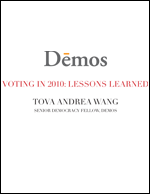From the standpoint of voter access and effective administration, the 2010 elections were in many ways a mixed bag. There were a number of troubling incidents that occurred including voter intimidation and threats of vote suppression, and the structural barriers to voting that keep participation rates down were as apparent as ever.
Yet at the same time it was clear that much of the worst that might have happened was avoided. While the lower turnout in mid-term elections clearly presents less of a challenge to election administration, we also may be seeing the fruits of close scrutiny of election processes in past years.
Major Themes in the Administration of the 2010 Elections
- Baseless fraud claims encouraged groups across the nation to engage in activities that interfered with and intimidated voters at the polling places. For example, groups encouraged members to photograph and videotape voters, and follow them around. One group even offered a $500 reward for vote fraud tips.
- The heated climate of anti-immigrant sentiment, aimed particularly at Latinos, led to unsubstantiated and occasionally outrageous claims about non-citizen voting. In Arizona, for instance, a Republic candidate cited “rumors” to slanderously accuse opponents of busing Mexicans over the border to vote.
- Restrictive voter registration requirements, such as 30-day deadlines, prevented many Americans from casting a ballot. Thousands of potential voters contacted Election Protection, the national hot line for voting-related information and complains, with questions about registration status or where to register – right before and on Election Day.
- Continued confusion over provisional ballots. In Illinois, voters entitled to a regular ballot received a provisional ballot, and voters entitled to a provisional ballot were refused one. Polling places in several Colorado counties ran out of the paperwork required for provisional balloting.
- Deceptive practices, including dissemination of misinformation about the voting process, continued. Robocalls and fliers told voters to bring their voter registration card and proof of home ownership to the polls (in Kansas, neither of which is required in the state) or to vote a day after Election Day (in Los Angeles).
- Most states complied with the new MOVE Act of 2009 and sent absentee ballots to overseas voters at least 45 days before the election. The Department of Justice compelled the states that were not able to comply with the new law to take steps that would ensure that the overseas ballots would be counted, saving about 65,000 votes as a result.
- Election officials in many parts of the country were wonderfully proactive in responding to baseless allegations of voter fraud and irregularities.
